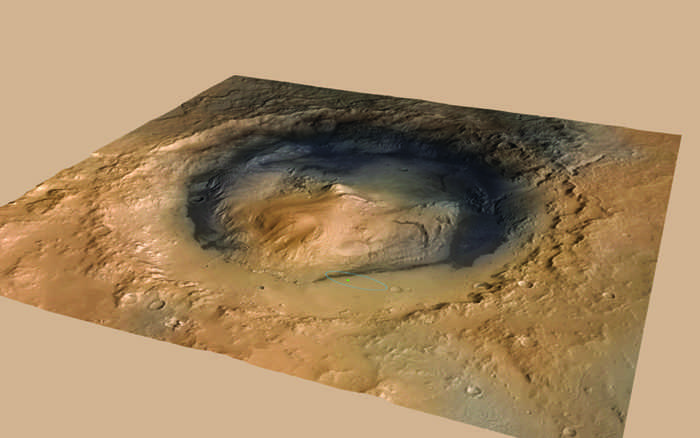NASA equipment discovers signs of water on Mars
Scientists using images from NASA's Mars rover Curiosity say they've found evidence for a river in Gale Crater. (NASA/JPL-Caltech/ESA/DLR/FU Berlin/MSSS)
October 29, 2015
On Monday, September 28, NASA released the statement that liquid water has been found on Mars. This monumental discovery gives hope to scientists that life possibly exists on Mars.
NASA’s Mars Reconnaissance Orbiter (MRO) provided the new evidence of water on Mars. The MRO detected hydrated minerals using an imaging spectrometer. The images captured by the MRO show slopes on the planet that are inferred to be created by flowing water. The slopes, named Coprates Chasma, have dark streaks called slope lineae that are evidence of the effects of flowing saltwater.
“We found the hydrated salts only when the seasonal features were widest, which suggests that either the dark streaks themselves or a process that forms them is the source of the hydration. In either case, the detection of hydrated salts on these slopes means that water plays a vital role in the formation of these streaks,” Lujendra Ojha of the Georgia Institute of Technology in Atlanta and the lead author of a report on these findings published Sept. 28 by Nature Geoscience, said.
“The presence of hydrated salts in these flows means that the streaks are forming due to contemporary water,” Ojha says.
The discovery was not a fast process. The MRO began scanning Mars in March of 2006. According to NASA, Mars research began to determine if life ever arose on Mars, to characterize the climate on Mars, to characterize the geology on Mars, and eventually prepare for human exploration.
“It took multiple spacecraft over several years to solve this mystery, and now we know there is liquid water on the surface of this cold, desert planet,” Michael Meyer said, lead scientist for NASA’s Mars Exploration Program in Washington.
Scientists have known that water has been present on Mars for a long while. However, the water has existed in polar ice caps, though. Mars is also covered with large patches of bare lane that once held oceans, rivers, and lakes billions of years ago.
The liquid water discovery improves the odds of other habitual life potentially on Mars. Many ask ‘Does life exist beyond Earth?”, and the liquid water provides some direction. The head of NASA’s hiRISE high-resolution Mars camera said he is confident that life will be found on Mars one day.
“It’s very likely, I think, that there’s life somewhere in the crust of Mars, microbes,” he said.
Finding evidence of liquid water on Mars is not as simple as it seems. Since water is a critical element to life, the discovery is a step closer for scientists to further research the opportunity of life on Mars.
“This is tremendously exciting,” James L. Green, the director of NASA’s planetary science division, said. “We haven’t been able to answer the question, ‘Does life exist beyond Earth?’ But following the water is a critical element of that. We now have, I think, great opportunities in the right locations on Mars to thoroughly investigate that.”
The discovery does not come without conflict. A major set back to the Mars research is because of treaty signed in 1967. Due to the 225 kilometers that the Mars rover Curiosity had to travel from Earth to Mars, there are possible contaminants that the robot picked up along the journey. While scientists sterilize the rover as much as possible, there is not a 100% guarantee that Earth life wont be contaminated. Even though there are pictures from the MRO showing evidence of flowing liquid water, the Mars rover cannot physically come in contacts with the source. The 1967 Outer Space treaty forbids those that signed the treaty around the world from sending a human, robot or spacecraft to a celestial source of water within a certain distance. Therefor, the obstacle must be worked around by other means of exploration, such as sending humans to Mars.
Undoubtedly, there will be bumps along the road of exploration. While the scientists have not discovered the source of the liquid water on Mars, the breakthrough creates hope for future research on Mars. Mars is still a mystery to scientists in most aspects, but liquid water might be the first of many discoveries to come for Mars research.

















